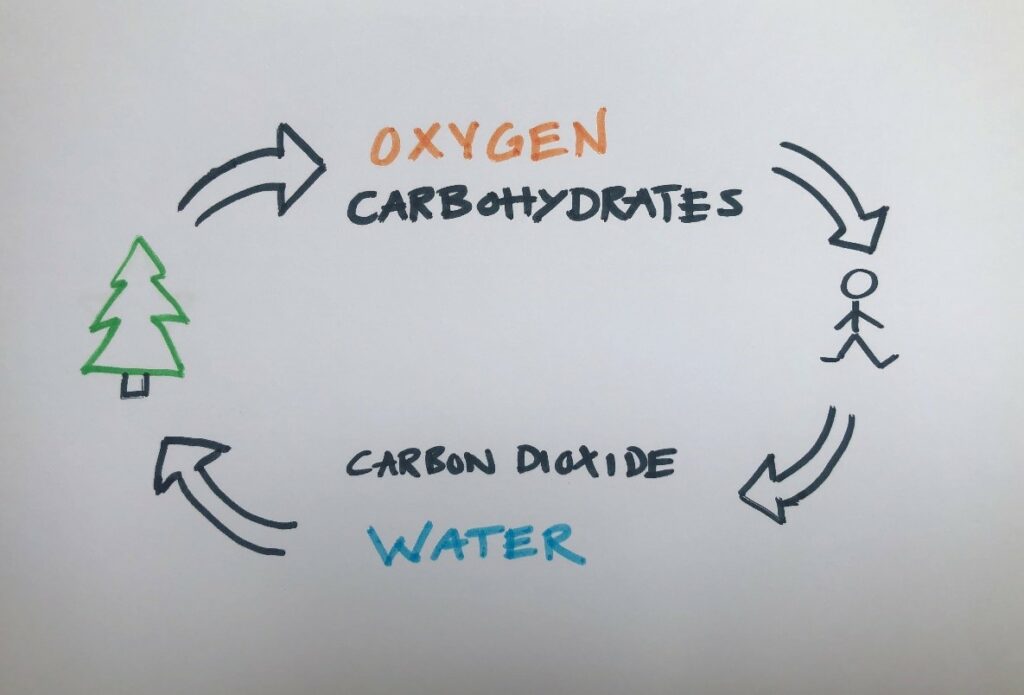Air is a word most of us are quite familiar with. We all need air to breathe. But what is air really? It’s a gas mixture that is everywhere around us in earth’s atmosphere, and it consists mainly of nitrogen and oxygen, but also carbon dioxide. To be more precise, it consists of this:
Nitrogen 78.1%
Oxygen 20.9%
Argon 0.9%
Carbon dioxide 0.04% 1
Often when we experience bad air we tend to say that “there’s no oxygen in the room”. But that’s not true at all. It is actually the last percentage of the content of the air that we should focus on instead of the oxygen. The percentage that consists of, among other things, carbon dioxide and a number of other gases.
What is carbon dioxide?
Carbon dioxide (CO2) is a naturally occurring, odourless gas, which is measured in parts per million, ppm. It is formed by the breathing of all aerobic organisms (plants, animals, fungi and many microorganisms), and is a natural part of the cycle shown below.
 Energy comes from the beginning from the sun. Plants capture the energy in sunlight in photosynthesis. The energy is then used to carry on the chemical reactions where carbohydrates are formed.
Energy comes from the beginning from the sun. Plants capture the energy in sunlight in photosynthesis. The energy is then used to carry on the chemical reactions where carbohydrates are formed.
People and animals eat food to get energy. The energy is released during the cell respiration when the oxygen burns the carbohydrates while carbon dioxide and water are formed. Carbon dioxide leaves the body with the exhaled air (exhale air from a human contains about 4% carbon dioxide.2 )
Outdoor
The outdoor content of carbon dioxide varies from around 350 in rural areas to 500 ppm or higher in urban areas. Outdoor sources are burning fossil fuels, such as gas and oil, transport, industry, and electricity generation.
Indoor
Indoors you can find much higher concentrations of carbon dioxide. And why is that? Because we breathe out carbon dioxide. We breathe in air, oxygen is consumed and CO2 is formed. At rest, a person produces 15 grams of CO2 per hour. With very heavy effort, the figure can increase to 600 grams per hour. So, the accumulation indoors is normally related directly to the number of people. But it can also come from non-living sources, such as space heaters, clothes dryers, stoves, or any other unvented gas-burning appliance.
And why should we care about carbon dioxide levels? They hardly ever cause any long term health problems, but short term it can cause common symptoms such as headaches, drowsiness, difficulties concentrating and a decrease in productivity / cognitive thinking skills.
Carbon dioxide is normally used as an indicator of air quality. When the carbon dioxide levels are high it’s an indication of stagnant, stale air which normally has more particles and emissions which in turn can cause other problems both for your health and for the building.
What are high carbon dioxide levels then?
400-800 ppm is the ideal state when you would feel comfortable. In well-ventilated homes or premises the carbon dioxide concentration is usually around 600-800 ppm.
Recommendations and guidelines
5,000 ppm Maximum concentration during an eight-hour working day.
2,000 ppm Fatigue increases as does the chance of headaches according to many studies.
1,000 ppm Recommended maximum level in Sweden and many other countries.
800 ppm Often recommended as maximum level for the staff to perform optimally.
400-600 ppm Risk of over-ventilation.
350-450 ppm Outdoor air concentration.
Absolute versus relative CO2
Usually it is actually the absolute value of CO2 that is measured, instead of the relative value which is more relevant to really understand the effect.
For instance, if the outdoor concentration is 400 ppm. The increase of CO2 concentration inside a room from 800 ppm to 1000 ppm is actually a 50% increase, not a 25% increase if comparing between 800 and 1000 ppm. This could be even more relevant in urban areas where local CO2 concentration outside can vary a lot and even up to 600-700 ppm.
Reducing CO2 levels
The best way to reduce carbon dioxide is to increase the airflow by turning up the ventilation system. If that’s not possible, opening doors or windows is the easiest way. Assuming that the outdoor air is clean of course.
We would like to promote a modern, demand controlled indoor climate system. This means that the air flow adapts automatically depending on how many people are in the room. Securing that you always have a healthy and productive indoor air quality.
In our next blog post we will explore volatile organic compounds, another important parameter when it comes to good indoor air quality.
If you would like to read more about indoor air, you can find a lot of interesting information on our website. And if you would like to dig into more of this type of content, you’ll find a number of articles on our blog.
Sources:
- SMHI – https://www.smhi.se/kunskapsbanken/meteorologi/luft-1.6034
- ^ [a b] Nationalencyklopedin multimedia plus, 2000 (uppslagsord Koldioxid)

